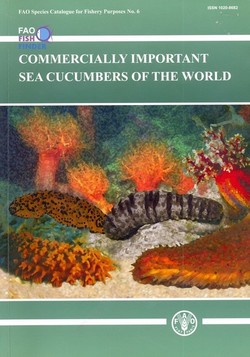
Commercially Important Sea Cucumbers of the World
FAO Species Catalogue for Fishery Purposes No.6
By
Steven W. Purcell
(National Marine Science Center – Southern Cross University – Coffs Harbour, NSW Australia)
Yves Samyn
(Royal Belgian Institute of Natural Sciences Brussels, Belgium)
Chantal Conand
(Professeur Emerite, Laboratoire Ecologie Marine Universite de la Reunion – Saint-Denis, France)
Abstract:-
Sea cucumbers are harvested and traded in more than 70 countries worldwide. They are exploited in industrialized, semi-industrialized, and artisanal (small-scale) fisheries in Polar Regions, temperate zones and throughout the tropics. In some fisheries, more than 20 species can be exploited by fishers and should be distinguished from each other by fishery officers and scientists. The processed (cooked and dried) animals, often called beche-de-mer or trepan, are exported mostly to Asian markets and need to be distinguished to species level by customs and trade officers. This book is intended as an identification tool for fishery managers, scientists, trade officers and industry workers to distinguish various species exploited and traded worldwide.
This book provides identification information on 58 species of sea cucumbers that are commonly exploited around the world. There are many other species that are exploited either in a small number of localities or in relatively small quantities, which are not presented. Species in some regions with active fisheries are also not represented due to limited information available (e.g. Mediterranean species). The accounts are based on more than 170 reports and research articles and by comments and reviews by taxonomists and field workers.
Two-page identification sheets provide sufficient information to allow readers to distinuish each species from other similar species, both in the live and processed (dried) forms. Where available, the following information for each species has been included: nomenclature together with FAO names and known common names used in different countries and regions; scientific illustrations of the body and ossicles; descriptions of ossicles present in defferent body parts; a colour photograph of live and dried specimens; basic information on size, habitat, biology, fisheries, human consumption, market value and trade; geographic distribution maps. The volume is fully indexed and contains an introduction. a glossary, and a dedicated bibliography. Readers are encouraged to base their identifications on a combination of morophological features, samples of ossicles from different body parts and information on what habitat and locality the species was found.
Contents:
Introduction.
General Remarks.
Glossary of Technecal Terms.



ساحة النقاش